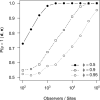Identifying, reducing, and communicating uncertainty in community science: a focus on alien species
- PMID: 36277057
- PMCID: PMC9579088
- DOI: 10.1007/s10530-022-02858-8
Identifying, reducing, and communicating uncertainty in community science: a focus on alien species
Abstract
Community science (also often referred to as citizen science) provides a unique opportunity to address questions beyond the scope of other research methods whilst simultaneously engaging communities in the scientific process. This leads to broad educational benefits, empowers people, and can increase public awareness of societally relevant issues such as the biodiversity crisis. As such, community science has become a favourable framework for researching alien species where data on the presence, absence, abundance, phenology, and impact of species is important in informing management decisions. However, uncertainties arising at different stages can limit the interpretation of data and lead to projects failing to achieve their intended outcomes. Focusing on alien species centered community science projects, we identified key research questions and the relevant uncertainties that arise during the process of developing the study design, for example, when collecting the data and during the statistical analyses. Additionally, we assessed uncertainties from a linguistic perspective, and how the communication stages among project coordinators, participants and other stakeholders can alter the way in which information may be interpreted. We discuss existing methods for reducing uncertainty and suggest further solutions to improve data reliability. Further, we make suggestions to reduce the uncertainties that emerge at each project step and provide guidance and recommendations that can be readily applied in practice. Reducing uncertainties is essential and necessary to strengthen the scientific and community outcomes of community science, which is of particular importance to ensure the success of projects aimed at detecting novel alien species and monitoring their dynamics across space and time.
Supplementary information: The online version contains supplementary material available at 10.1007/s10530-022-02858-8.
Keywords: Biodiversity monitoring; Citizen science; Data quality; Epistemic uncertainty; Linguistic uncertainty; Non-native species.
© The Author(s) 2022.
Conflict of interest statement
Conflict of interestThe authors declare no conflict of interest.
Figures






References
-
- Aceves-Bueno E, Adeleye AS, Feraud M, Huang Y, Tao M, Yang Y, Anderson SE. The accuracy of citizen science data: a quantitative review. The Bull Ecol Soc Am. 2017;98(4):278–290. doi: 10.1002/bes2.1336. - DOI
-
- Adriaens T, Gomez G, Maes D. Invasion history, habitat preferences and phenology of the invasive ladybird Harmonia axyridis in Belgium. Biocontrol. 2008;53:69–88. doi: 10.1007/s10526-007-9137-6. - DOI
-
- Adriaens T, Sutton-Croft M, Owen K, Brosens D, van Valkenburg J, Kilbey D, Groom Q, Ehmig C, Thürkow F, Van Hende P, Schneider K. Trying to Engage the Crowd in Recording Invasive Alien Species in Europe: Experiences from Two Smartphone Applications in Northwest Europe. 2015 doi: 10.3391/mbi.2015.6.2.12. - DOI
-
- Aebischer T, Ibrahim T, Hickisch R, Furrer RD, Leuenberger C, Wegmann D. Apex predators decline after an influx of pastoralists in former Central African Republic hunting zones. Biol Cons. 2020;241:108326. doi: 10.1016/j.biocon.2019.108326. - DOI
-
- Azzou AK, S., Singer, L., Aebischer, T., Caduff, M., Wolf, B., & Wegmann, D. A sparse observation model to quantify species distributions and their overlap in space and time. Ecography. 2021;44(6):928–940. doi: 10.1111/ecog.05411. - DOI
Publication types
Grants and funding
LinkOut - more resources
Full Text Sources
Research Materials
